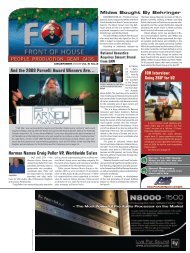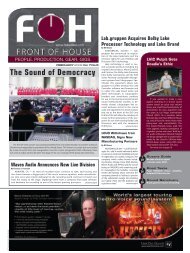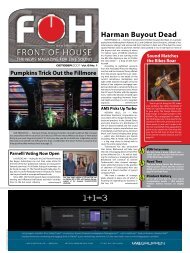You also want an ePaper? Increase the reach of your titles
YUMPU automatically turns print PDFs into web optimized ePapers that Google loves.
Come Together<br />
Have you noticed the music in your elevator<br />
getting better lately? Installed<br />
sound, in general, has taken leaps forward<br />
in terms of quality and management in<br />
the last few years. At the InfoComm show in<br />
June, the purveyors of installed sound systems<br />
gave plenty of praise to the live sound sector<br />
for raising the sonic bar across the board. They<br />
cited how the enhanced emphasis on touring<br />
in the music business has raised expectations<br />
of consumers for better audio in all aspects of<br />
their lives.<br />
Install Prime Time biz<br />
And if imitation is flattery, their live sound<br />
counterparts are returning the favor in the form<br />
of adapting gear to meet the requirements of<br />
the installed sound universe. David Scheirman,<br />
vice president of tour sound for JBL Professional,<br />
says the inherent robustness of live sound<br />
technology makes it ready for install prime<br />
time. “Product characteristics like integral, loadrated<br />
suspension fixtures and comprehensive,<br />
standardized software for remote control and<br />
monitoring all make tour sound products readily<br />
adaptable to the needs of the fixed installation<br />
sound system market,” he says.<br />
Paul Freudenberg, vice president of sales<br />
and marketing with L-ACOUSTICS, pointed<br />
to the more stylishly rounded and nuanced<br />
rigging connector on the company’s 112<br />
XGH cabinet. “In the old days, you’d have to<br />
fasten the dolly boards, and it didn’t matter<br />
much how it looked as long as it worked,”<br />
he says. “But if the cabinet is going to be installed<br />
and becomes part of the interior design,<br />
it needs to look like it was esthetically<br />
designed.”<br />
40<br />
The Biz<br />
Theory and Practice<br />
Apples and Oranges biz<br />
This was only L-ACOUSTICS second InfoComm<br />
appearance, an arrivisté status<br />
they shared with several other live sound<br />
companies at the show. As recently as just<br />
five years ago, manufacturers regarded live<br />
and installed audio as apples and oranges.<br />
But that all changed with phenomenon like<br />
churches morphing into performance spaces<br />
and traditionally static spaces like retail<br />
stores and museums looking to create im-<br />
mersive lifestyle environments with sound<br />
as a critical element. With the inclusion of<br />
the NSCA expo merged with this show, Info-<br />
Comm, this year, underscored the extensive<br />
convergence that’s taking place between<br />
live and installed audio.<br />
Jeff Rocha, sales director at EAW, says the<br />
convergence has been taking place at the<br />
highest levels. “When CEOs hear touring acts<br />
sound great at their corporate events, it naturally<br />
follows that they won’t want less when it<br />
comes to sound in other parts of their businesses,”<br />
he says. EAW is also restyling some of<br />
its gear to give a better esthetic in installed<br />
applications. He adds that mid-sized and<br />
small line arrays have literally had a new niche<br />
created for them in installed scenarios.<br />
“It’s not that touring equipment hadn’t<br />
been used in installed sound situations like<br />
theaters and even churches,” he explains.<br />
“It’s that more spaces are becoming performing<br />
spaces” — retail, airport concourses,<br />
theme parks — “and the industry is learning<br />
to adapt touring sound technology into<br />
applications that used to be serviced by<br />
installed sound gear that wasn’t necessarily<br />
appropriate for music.” Dan Montecalvo,<br />
marketing manager for Audio-Technica, puts<br />
it succinctly: “More people are coming from<br />
More people are coming from the live-sound<br />
side of the business over to installed sound, and<br />
they’re bringing the stuff they like with them.”<br />
— Dan Montecalvo, Audio-Technica.<br />
Less Than Zero<br />
Zeroing out a console — the methodical<br />
process of bringing all the live audio<br />
mixing console knobs, faders and<br />
switches to a benign state of usage. This way<br />
the future engineer using the console will<br />
not have to be observant of every last detail<br />
before connecting the system to the console<br />
and fear immediate mayhem. But zeroing out<br />
a console is more than a courtesy after the gig;<br />
it should also be a practice before the gig.<br />
The Process tp<br />
Zeroing out most analog consoles typically<br />
starts with the faders. Unless the console<br />
is partially active providing recorded music<br />
before the gig, you want to turn down all the<br />
faders, including the main left-center-right,<br />
auxiliary, subgroup and channel strip faders.<br />
Yeah, having mute groups on helps, but until<br />
you have programmed them or understand<br />
why other channel faders have to be up, send<br />
all the faders to the bottom and hunt down<br />
the channel strip equalizers and flatten them<br />
all at unity gain first.<br />
I recommend centering the swept frequency<br />
controls on the parametric equalizers<br />
and choosing wide frequencies for high- or<br />
low-pass filters. Nothing aggravates the next<br />
console driver more than high-pass filters<br />
stuck at 200 Hz when gig time pressure is<br />
on. Choose a more wide-open value like 80<br />
Hz or lower to let the next person narrow up<br />
the response bands. Leave the channel strip<br />
equalizer strips “inserted” and not bypassed<br />
— another hair-pulling aggravation in stressful<br />
gigs with no zero-out time.<br />
For channel strip gains and assorted other<br />
preamp controls, bring the gains back down<br />
to around the 10 o’clock position with the XLR<br />
jack as the chosen input. Also, you can remove<br />
the pads, polarity flips and phantom power<br />
settings as you regain the channels. If there<br />
are high-pass switches or controls, leave the<br />
switches engaged or back off the controls to<br />
a low frequency so that channels needing extra<br />
bottom-end will have action taken by the<br />
next user. Nothing like chasing hum on channels<br />
not needing subwoofer support. For auxiliary<br />
sends, send them all packing back to full<br />
attenuation until you have effects and other<br />
mixes to support. Pay extreme attention to<br />
the pre/post and stereo/dual mono switches.<br />
A safe bet is leaving things in post-fader mode<br />
and each aux control in mono send mode.<br />
AUGUST 2008 www.fohonline.com<br />
the live sound side of the business over to installed<br />
sound, and they’re bringing the stuff<br />
they like with them.”<br />
Converging Markets biz<br />
Seeing veteran live sound mixer Robert<br />
Scovill, now marketing manager at Digidesign,<br />
at an installed sound exhibition viscerally<br />
clinches the sense of convergence between<br />
the two sectors.<br />
“From the manufacturers’ perspectives,<br />
the line has gotten pretty blurry,” he agrees.<br />
It’s also affecting Digi’s product and marketing<br />
strategy to an extent. “We’re not so<br />
much adapting the technology for the market<br />
as building scale for installed sound,” he<br />
explains. “We want to continue to work from<br />
a single-software platform, but we’re also<br />
Tackling the master section is mostly<br />
common sense. Once all the faders are down,<br />
check the signal routings and un-flip any fader<br />
flip switches so that groups and aux send<br />
masters are obvious. Also, check for global<br />
pre/post settings on aux masters on lower<br />
cost consoles. Then back down on the headphone<br />
monitoring levels and choose the L-R<br />
mix as the default monitor when a PFL or AFL<br />
switch is not activated. And, of course, leave<br />
the mute group in a safe condition with all<br />
channels muted by the groups or with individual<br />
channels muted if not in a mute group.<br />
If you have marked up board tape on the<br />
console, it is at your discretion to remove it.<br />
There is no reason to leave it on the console if<br />
a good zeroing out is performed. The exceptions<br />
would be if the next act is keeping the<br />
same mic patching or if there are bad channels<br />
that need identification.<br />
The Courtesy tp<br />
At the end of a gig, it is a nice courtesy<br />
if you zero out the console to leave it for the<br />
next user. Of course, if it is very likely you will<br />
be the next user, you may gamble on leaving<br />
things half-zeroed so that EQ settings and<br />
By DanDaley<br />
going to continue to move downmarket to<br />
build products that are smaller and that can<br />
address more markets.” Digi is also reconfiguring<br />
its existing products, such as creating a<br />
single-rack solution for its Icon console that<br />
eliminates the need for a snake, making it a<br />
better fit for fixed installations.<br />
In fact, Scovill confides, in the four years<br />
that Digidesign has exhibited at InfoComm,<br />
it took a while to realize that it wasn’t a matter<br />
of selling the odd console into the fixedsound<br />
market, but rather branding their way<br />
into it. “We realized we needed to position the<br />
brand, not just the technology and products,”<br />
he says. “It’s the difference between seeing<br />
a market where we can sell some stuff and<br />
a market where we can create demand that<br />
wasn’t there before.”<br />
Kevin Hill, managing director at Spanish<br />
speaker maker D.A.S., says the branding<br />
aspect is being helped by the fact that live<br />
sound companies are increasing the amount<br />
of installed sound work they do to balance<br />
revenues during off-touring seasons. “Historically,<br />
those customers have not been as<br />
brand-conscious as the touring clients are,”<br />
he says. “But that’s changing as the big touring<br />
sound providers are doing more installed<br />
work. They’re bringing brand awareness with<br />
them into this marketplace.”<br />
The increased emphasis on live touring<br />
sound as the music industry’s core revenue<br />
stream has been a boon to live sound systems<br />
manufacturers, but it’s also brought<br />
more competition to the field — it sometimes<br />
feels as if there is an individual microphone<br />
for every independent artist on the road.<br />
continued on page 43<br />
By MarkAmundson<br />
preamp gains are left for the next performance.<br />
An efficient console operator should<br />
be able to dial in EQ and rough gains very<br />
quickly from a zeroed-out console.<br />
Zeroing before the gig also helps familiarize<br />
yourself with the console if you have not<br />
been on that brand/model for a while. Feeling<br />
all those controls and faders may provide<br />
a clue on how well-maintained the console is<br />
before mixing. Loose controls and sticky faders<br />
may provide a scenario of how to defensively<br />
drive the console to avoid crackles and<br />
pops before the show goes on.<br />
The Ego tp<br />
I once had an ego enough to not zero<br />
out the console because I wanted the next<br />
user to see the mixing prowess I had as a<br />
teaching aid. Today, I am much more likely<br />
to play nice and zero out for fear that someone<br />
else will see my bad mixing habits instead.<br />
But there is another reason to zero out<br />
each night, especially when you really are a<br />
good console operator, to the point where<br />
your pay is very well up in the compensation<br />
ranks.We know of a few <strong>FOH</strong> engineers<br />
continued on page 43

















